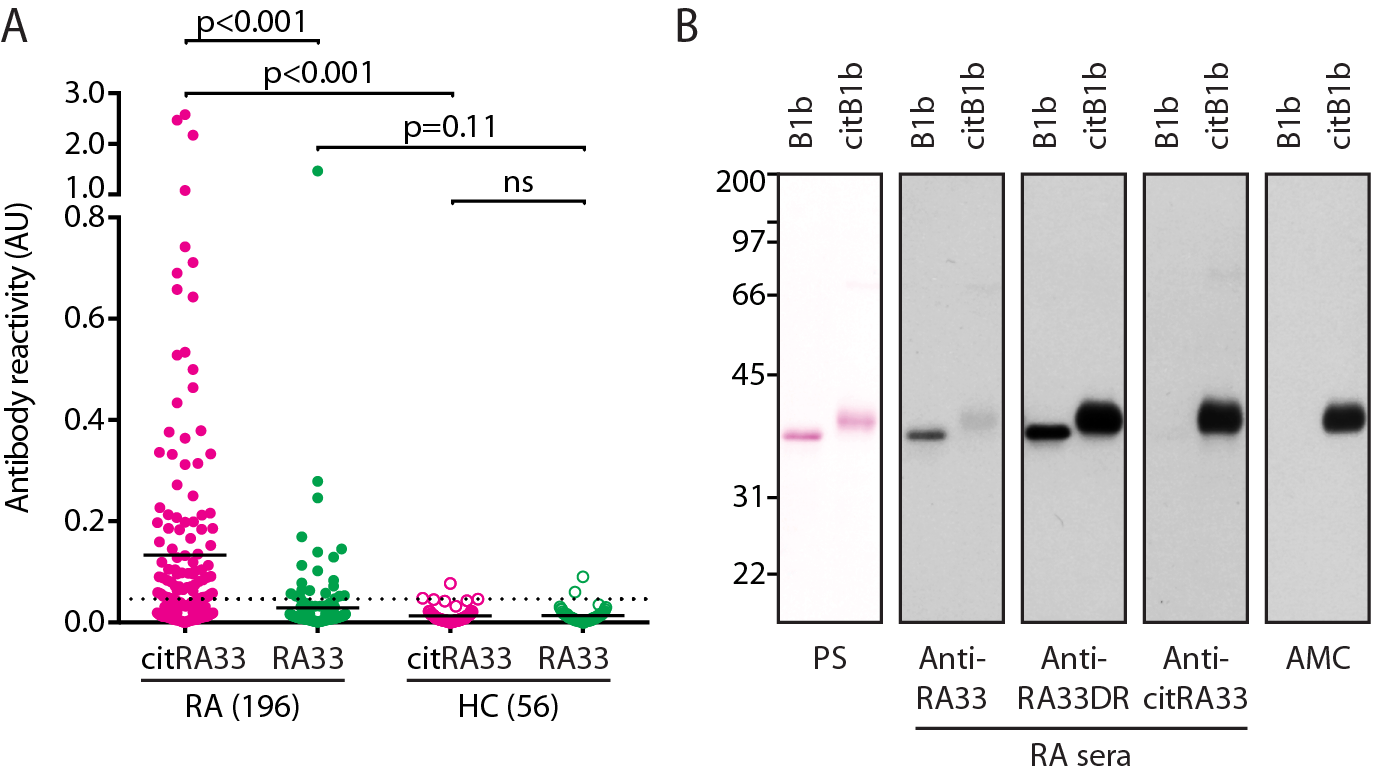Session Information
Date: Tuesday, November 10, 2015
Title: Rheumatoid Arthritis - Clinical Aspects IV: Biomarkers, Disease Progression and Treatment Response
Session Type: ACR Concurrent Abstract Session
Session Time: 2:30PM-4:00PM
Background/Purpose:
Antibodies against RA33 (hnRNP A2/B1) were one of the
earliest antigen specificities identified in rheumatoid arthritis (RA). Unlike
the erosive disease associated with anti-citrullinated proteins antibodies (ACPAs)
and rheumatoid factor (RF), anti-RA33 antibodies have been uniquely associated
with a milder disease phenotype. In preliminary studies, we identified that
RA33 is citrullinated in RA synovial fluid (SF), and targeted as citrullinated
protein in RA. Here, we define the clinical utility of antibodies against
unmodified (native) and citrullinated RA33 (citRA33) in a longitudinal cohort
of patients with RA.
Methods:
RA33 splicing variants (hnRNP A2/B1/A2b and B1b) were
cloned from RA SF cDNA, and recombinant proteins citrullinated in vitro using
human rPAD4. Antibody reactivity against native and citrullinated splicing
variants of RA33 was compared by ELISA using ACPA-positive RA sera. Patient
sera from a cohort study of subclinical cardiovascular disease in RA (n=196)
and healthy control sera (n=56) were assayed for antibodies against native and
citrullinated B1b by ELISA. Antibody specificities were confirmed by
immunoprecipitation and immunoblotting. Antibody positivity was defined based
on seroreactivity above the 95th percentile of controls, and
correlated with markers of disease activity and radiographic progression.
Results:
Anti-citRA33 antibodies were identified in 86 patients
(44%) with RA, while anti-native RA33 antibodies (anti-RA33) were detected in
21 patients (11%) at first visit. Analysis of the fine specificities recognized
by these antibodies in patients with RA demonstrated that RA33 is targeted in
three ways: (1) exclusively as a citrullinated antigen (n=75); (2) both as a
native and citrullinated antigen (n=11); and (3) exclusively as a native
antigen (n=10). Patients with anti-citRA33 specific antibodies had a median
baseline Sharp-van der Heijde score (SHS) that was 3.4-fold higher than
antibody negative patients (17 vs. 5 units, p=0.006). In contrast, anti-RA33
specific antibodies identified patients with the lowest systemic inflammatory
burden as measured by CRP and IL-6 levels, and with erosion scores similar to
those without either antibody (1.2-fold increase; p=0.81). Minimal longitudinal
progression of erosive damage was observed among patients with anti-RA33 alone
or anti-citRA33 alone (SHS change/year 0.0 and 0.6, respectively). In contrast,
the subset of patients with reactivity against both RA33 and citRA33
(anti-RA33DR) demonstrated a significantly higher rate of radiographic
progression (SHS change/year 2.3; p=0.035).
Conclusion:
Anti-citrullinated and anti-native RA33 antibodies identify
distinct clinical subsets in RA that differ in disease duration and phenotype.
Anti-RA33DR antibodies characterize a unique group of patients with markedly
accelerated progression of erosive disease.
To cite this abstract in AMA style:
Konig MF, Giles J, Nigrovic PA, Andrade F. Anti-RA33 Citrullinated/Native Double-Reactive Antibodies Identify Patients with the Highest Risk of Radiographic Progression in Rheumatoid Arthritis [abstract]. Arthritis Rheumatol. 2015; 67 (suppl 10). https://acrabstracts.org/abstract/anti-ra33-citrullinatednative-double-reactive-antibodies-identify-patients-with-the-highest-risk-of-radiographic-progression-in-rheumatoid-arthritis/. Accessed .« Back to 2015 ACR/ARHP Annual Meeting
ACR Meeting Abstracts - https://acrabstracts.org/abstract/anti-ra33-citrullinatednative-double-reactive-antibodies-identify-patients-with-the-highest-risk-of-radiographic-progression-in-rheumatoid-arthritis/

